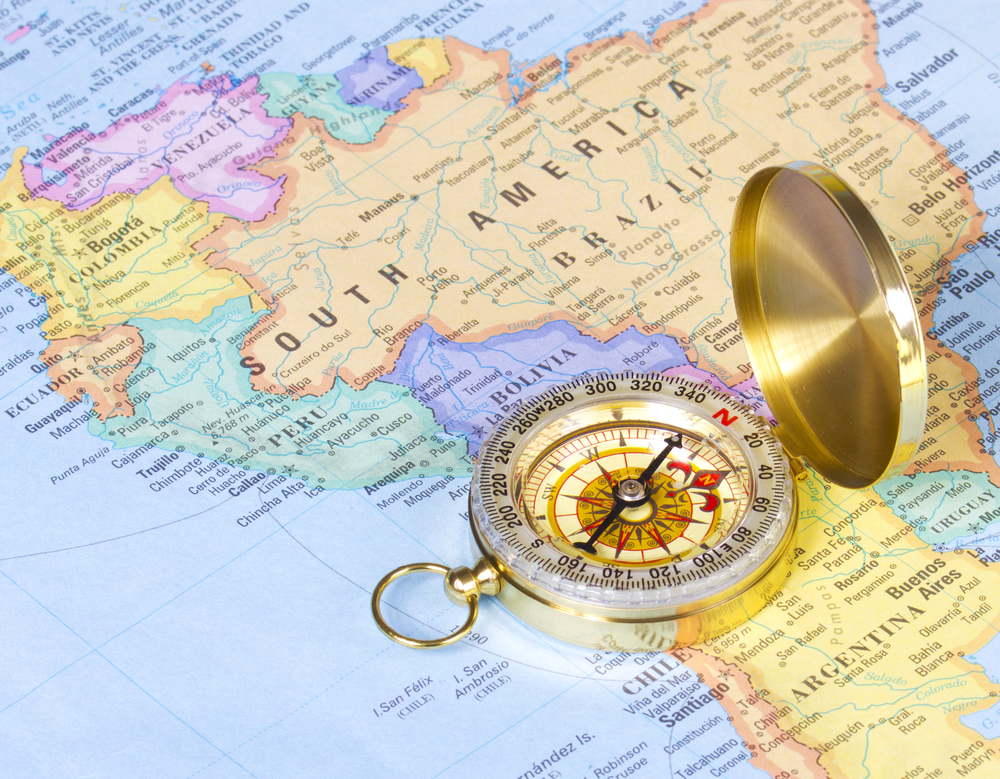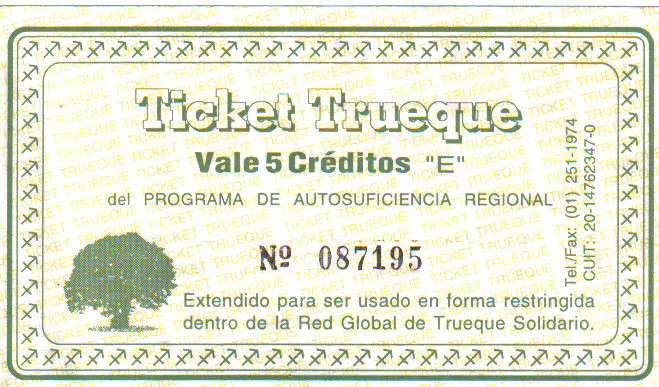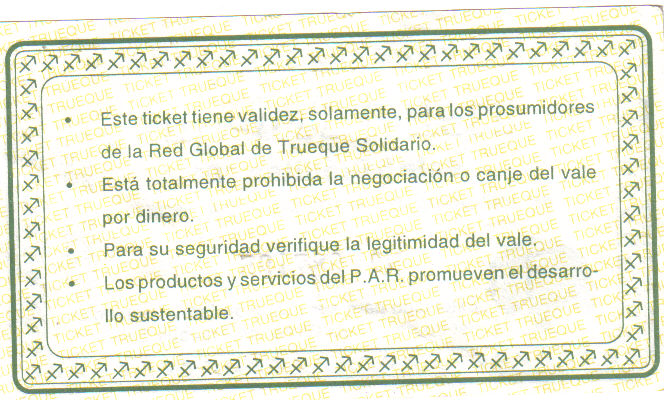Barter and "Magic Realism"
By Ibsen Martinez

Wars, natural disasters, and distressful economic crisis have forced barter among adult people in all times, too. So mankind’s oldest form of exchange would seem to be related to strong, basic human instincts.
Yet the invention of money hints at a kind of enigmatic human ingenuity that defied definition for centuries as if it was a godlike gift akin to that of the invention of writing.
In recent years, however, the enormous difficulties faced by former communist countries in their transition to a market economy fostered the emergence of barter, especially in Russia, where it showed a phenomenal growth since 1993. At approximately the same time, barter burgeoned in Argentina and reached amazing levels of activity.
Russia’s departure from conventional monetary transacting during the 1990s began almost at the very start of the transition. 1992 double-digit hyperinflation rates per month literally wiped the savings of most Russians.
An ill-timed liberalization of prices added to the common citizen’s plight. National production fell by almost 60% during 1990-99. Over that same period of time, Russia’s GDP had a fall of 54%.
One favorite explanation for both inflation and a barter upsurge in Russia during the early 1990s emphasizes the all-pervading disorganization that followed the Soviet system collapse. But a working paper prepared for the Chief Economist of the European Bank for Reconstruction and Development (EBRD) in 1998, suggests that Russian barter cannot be explained away merely by sudden social system “disarray”.1
According to its authors, a tremendous liquidity squeeze would account for the shift to non-monetary transactions in post-communist Russia. Of course, there is no way to get around a certain inherited “cultural” element: Russian barter built on large networks and skills developed during the previous shortage-plagued system of centralized planning.
Thus, many state firms that had fallen into arrears took to paying their employees in bartered goods. But the remaining fact is that both private persons and firms lost confidence in the ruble. Everyone feared an imminent devaluation.
To be true, barter was something of a “cultural remnant” of Soviet-era daily practices, not only among individuals but also among state-owned firms that made extensive use of various surrogates of money for decades.
It looked natural that high inflation, just one of the many transition problems faced by Russia in the 1990s, reinforced non-monetary transactions, be it among individuals or groups of firms, as well as between firms and tax authorities. Macroeconomic stabilization programs that were attempted in those days implied a sharp tightening of monetary policy.
Nevertheless, fiscal sources of instability somehow remained unattended, or just could not be reined in, by local officials. This had consequences for the integrity of the banking system that ultimately collapsed.
Lack of current capital then led many firms to keep on bartering simply to “stay alive” in a cash constrained “capitalist” environment. Inevitably, barter also raised the potential of many “sick” firms to survive without restructuring nor downsizing. The largest and the worst managed firms prevailed over the few small but sound Russian entrepreneurial ventures.
Barter among large firms brought about incentives to “cook the books” by inflating costs and understating revenues. Such tremendous lack of transparency of a large-scale non-monetary economy soon curtailed outside finance. On top of all this, tax authorities took to accepting payments in kind. As it soon turned out, massive tax paying in kind became another incentive for corruption.
In early 1998 the use of barter and other money surrogates in Russia reached an historical peak. In August of that same year, only a few weeks after a long-awaited $4.8 billion IMF “rescue” loan finally came in, Russia declared a suspension of payments and a devaluation of the ruble. As consequence, a global financial crisis set in.
For more on black markets, see these references from the Concise Encyclopedia of Economics.
Now comes a telling paradox: devaluation encouraged local goods-production that, in time, took a significant share of the Russian domestic market, leading to the growth or a real economy as opposed to a black one. This, and an unexpected windfall of oil revenues—linked to a sustained rise of crude oil prices once the East Asian crisis came to an end—marked the beginning of the end of barter in the former USSR.
A fact worthy of attention is that during those “barter years” almost no one in Russia ever thought of building an alternative to capitalism based in money surrogates, nor was anyone looking for “a third way” to national wealth and social justice propelled by a non-monetary economy.
Russians relied on barter only to survive in a cashless environment while striving, at the same time, towards a full-fledged market—and, yes, monetary—economy. This was not the case in Argentina.
Unlike what happened in Russia, Argentina’s barter was seldom used by firms. Right from the outset it was favored almost exclusively by millions of private individuals, mostly middle-class people, who were trying to find a way around a crippling economic downfall.
The intriguing fact is that, after a full decade, the kind of barter that emerged in Argentina in the 1990s to cope with problems somewhat similar to those the Russians were going through, has remarkably attained an appealing ideological quality throughout the rest of Latin America.
Indeed, barter “activism” in Latin America no longer advocates payment in kind as a provisional resort to cope with hyperinflation, lack of credit or unemployment.
It has grown into an extravagant proposal of social organization based on a disjointed assortment of anti-capitalist slogans. Barter is described as a paradigm for a new economy. This anti-capitalist bias is best illustrated by such fuzzy expressions as “social money”, “market economy without capitalism”, or “market anarchism”.
Latin American academic industry has found in “el trueque”—the Spanish word for barter—an unexpected subject for lucubration: “culturally sustainable economy.”
Wherever you cast an eye in Latin America you can sort out barter pundits who write papers on barter and attend to conferences on the future of barter organized by barter-oriented NGO’s (Non-Governmental Organizations) that somehow manage themselves to raise government’s funding for multiple-discipline research on, say, forms of payment that date back to Pre-Columbian times. Words like “tlaloc”—the Aztec god of fertility—are in vogue in Latin America’s academia.
Overstatements abound and prophecies are profusely offered to the believers in barter, that unselfish germ of the future. And all this regardless of the unquestionable failure of barter as a substitute for a sound economy. How did all this come to be?
In 1995, unemployment reached 18.7% in Argentina. On a May night, a group of neighbors of Bernal, a small city in the Buenos Aires Province, met to discuss ways to face an appalling economic recession characterized not so much by hyperinflation but by asphyxiating cash constraints.
The group was led by three young men that had been involved in activities aimed at boosting communal kitchen gardens, garbage recycling and the use of wind and solar energy.
Success in kitchen gardening and garbage recycling—they never got very far in solar energy—made them think that they could also put their talents to the improvement of global economy. So the first Argentinean “club de trueque”—Spanish for “barter club”—was founded in May 1995.
“We read a lot”, recalls one founder in a recent interview,2 and then goes to tell that authors as disparate as Alvin Toffler and Mahatma Gandhi modeled their weltanshchauung. He insists, however, that the main source of their ideas was Jean Silvio Gessel, a 19-century Belgian merchant and finance theoretician who, in 1906, wrote his most famous book: The Natural Economic Order. Gessel advocated a currency which would depreciate over time, at scheduled intervals, as users chipped off portions of it.
The recession caused by the Mexican currency crisis rippled down the continent, striking Argentina. Public servants went without pay for months once the government ran out of cash for salaries. Why not try barter?
People would meet in weekly “barter fairs” where they took an old electric appliance or a leather jacket and exchanged them for bread or dairy products. They would write their names and professions or the line of products they manufactured. They also would write what their wants were. One barter club’s tenet: “Don’t bring money, just bring something to sell.”
Barter clubs became, at their best, an improbable safety net for a middle class unaccustomed to the hardships that were a way of life elsewhere in the continent. The idea caught on and spread throughout the country. In a matter of months barter clubs began trying exchanges with other barter clubs.
J. S. Mill wrote:
“A tailor, who had nothing but coats, might starve before he could find any person having bread to sell who wanted a coat: besides, he would not want as much bread at a time as would be worth a coat, and the coat could not be divided.” Principles of Political Economy, par. III.7.3.
For a recent application, consider Paul Seabright, The Company of Strangers: A Natural History of Economic Life. Princeton University Press, 2004, Chapter 4, page 74:
“Even with sophisticated computer– and internet–based systems for bringing about a double coincidence of wants, barter will always run up against a fundamental problem: when searching for someone who wants to buy what I have to sell, how can I be sure that what he has to offer in return is of the quality I require? The attraction of money is precisely that I can be more confident of its quality than I can of almost anything else a buyer can offer. Barter will always survive where participants have already overcome the problem of trust in other ways: in small communities where people know each other well, and even on a larger scale where the goods exchanged are sufficiently standardized for their quality to be quickly verifiable without much effort. But as a means of mediating the exchange of inscrutables between strangers, on which more and more of modern life is based, no realistic alternative to money has ever yet been found.”
For some early uses of the term “double coincidence of wants”, see Jevons, Wicksteed, and Marshall.
But when you have almost 5,000 barter clubs involving 2.5 million people unknown to each other, you have to face the problem of how to asses the value of such a variety goods and services recorded in barter clubs’ databases.
Barter clubs began printing scrips in a futile attempt to cope with barter’s essential drawback, one that Mr. John Stuart Mill sorted out long ago in his famous “tailor and baker” fable. Barter just cannot ensure “double coincidence” as money does.
Argentina’s barter club vouchers are, to my mind, a fine example of “magic realism”, a literary genre in which Latin America novelists like Gabriel García Márquez excel. The coupons were never called “money”. Still they were supposed to be reservoirs of value, hence could be accepted as payment. Who backed the scrip? The barter club, of course. Did the barter club adopt a measure of value unit? Yes, and it was called “credit”. The face value of one credit equaled that of the national currency unit, the peso.
Barter club’s activity dwindled after a couple of years, and remained no more than a trend at the outer edge of economy. But then economic crisis broke out again and reached its lowest point in 2002 with the government’s default on $141 billion in foreign debt. The barter craze once more gained tremendous momentum. That’s when they took to printing “social money”. US $7 millions of scrip went into circulation and, allegedly, $400 millions in goods were traded.
In January 2003, a gang of burglars broke into the vaults of a printing house where millions of barter coupons were kept. The gang then went into a shopping spree. Apparently, they were in the know about an upcoming agreement between Argentina’s government and the IMF, because once the IMF’s “fresh money” had flooded the country; the burglars sold the goods—mostly used home appliances—at incredibly discount prices, but paid themselves in US dollars.
Only a few weeks ago, Argentina, along with Brazil, decided to pay its entire debt with the IMF, thus canceling a controversial conditionality that have been bitingly criticized by many economists the world over. You would say that no better sign that enough cash is flowing back into Argentina could be found. Well, here is one: barter clubs are gone.
“The world makers and the world improvers responsible for these notions feel no obligation to follow up their ideas inexorably to their final consequences. They prefer to call a halt where the difficulties of the problem are just beginning. And this, incidentally, accounts for the longevity of their doctrines; so long as they remain nebulous, they offer nothing for criticism to seize upon.”—(Ludwig von Mises, The Theory of Money and Credit, par. I.6.9)
Yet the jargon, the academic industry, the pundits and the websites linger on. That’s why a Brazilian-born social scientist who co-founded the so-called “Red Global de Trueque—Global Barter Network”—an NGO based in Buenos Aires, travels extensively throughout the region lecturing on “Barter in the Third Millennium: Alternative Money and Citizen’s Empowerment”.
I’d rather have those scrip burglars lecture me.
For more articles by Ibsen Martinez, see the Archive.


